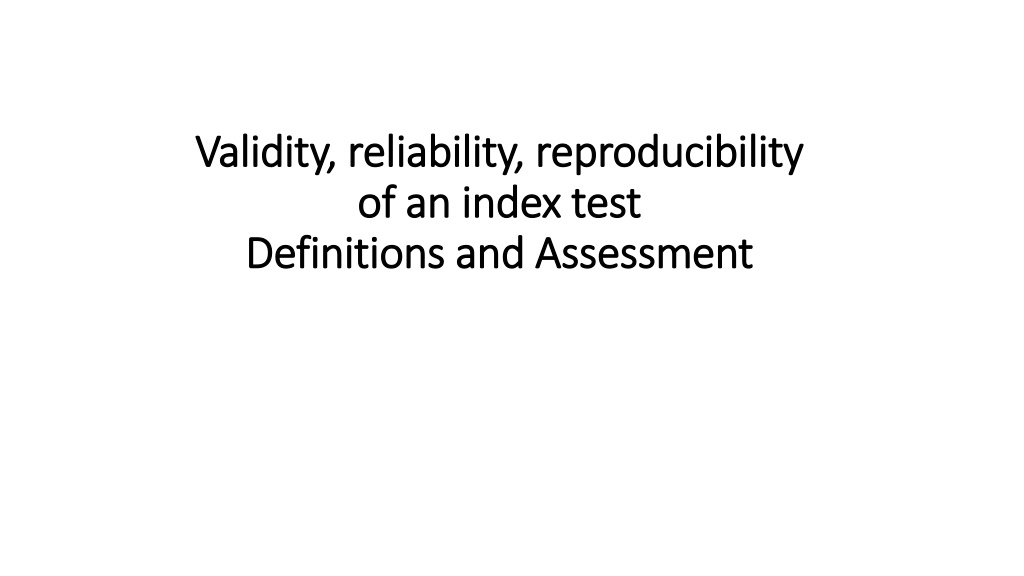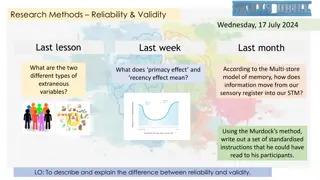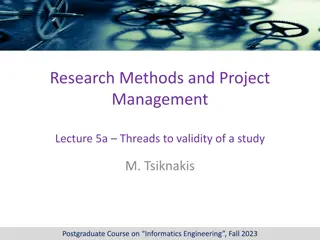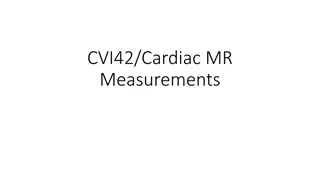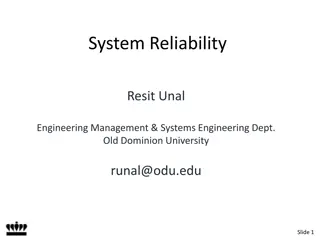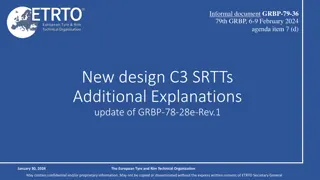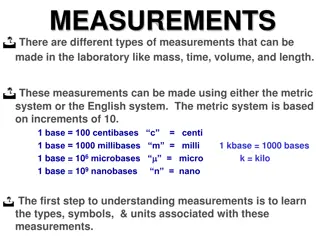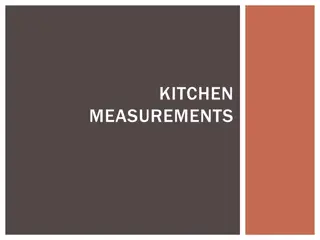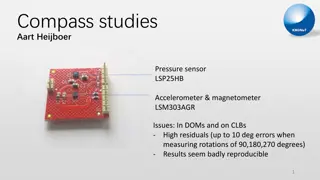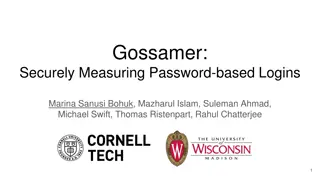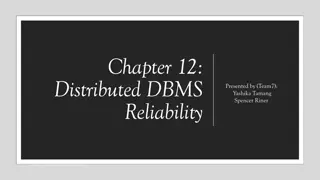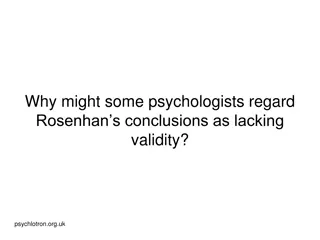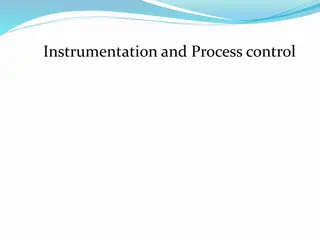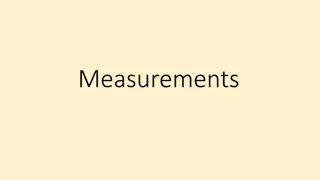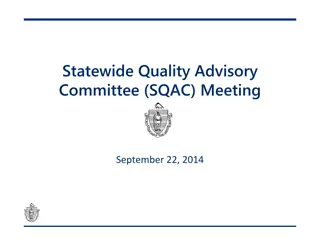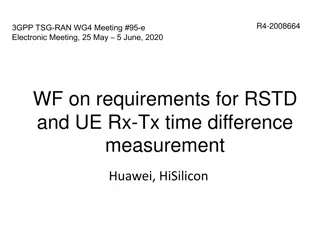Understanding the Importance of Validity, Reliability, and Reproducibility in Clinical Measurements
Clinical practice involves measuring quantities to aid in diagnosis, predict patient outcomes, and serve as study endpoints. Errors in measurements can lead to inaccurate results and affect clinical decisions. Trueness and precision, accuracy, bias, and method comparison are essential concepts in assessing the validity, reliability, and reproducibility of index tests. It is crucial to ensure that new measurement methods are comparable to established ones to maintain accuracy and reliability in clinical practice.
Download Presentation

Please find below an Image/Link to download the presentation.
The content on the website is provided AS IS for your information and personal use only. It may not be sold, licensed, or shared on other websites without obtaining consent from the author. Download presentation by click this link. If you encounter any issues during the download, it is possible that the publisher has removed the file from their server.
E N D
Presentation Transcript
Validity, reliability, reproducibility Validity, reliability, reproducibility of an index test of an index test Definitions and Assessment Definitions and Assessment
Clinical practice involves measuring quantities for a variety of purposes, such as: aiding diagnosis, predicting future patient outcomes, serving as endpoints in clinical studies. Measurements are always prone to various sorts of errors, which cause the measured value to differ from the true value. Pre-analytical factors are a major source of variability in laboratory results: failure to identify these factors can lead to falsely increased or decreased results and to erroneous clinical decisions.
Trueness and Precision The trueness (accuracy) refers to the closeness between the mean of a large number of results and the true value or an accepted reference value. The precision (agreement) refers to the closeness between repeated measurements on identical subjects. Different factors may contribute to the variability found in repeated measurements: Observer, Instrument, Environment, Time interval between measurements, Precision consists of both: - repeatability (factors constant) - reproducibility (factors variable).
Accuracy + P + r e c i s i o n True values Error prone measurements
Bias = x/n SD = [ (x m)2/n]1/2 Random error Systematic error ICC = SD ICC = SDB B2 2 / (SD / (SDB B2 2 + SD + SDW W2 2) ANOVA (random effect) ) ANOVA (random effect)
Method comparison Method comparison Before we use a new measurement method in clinical practice, we must ensure that the measurements it gives are sufficiently similar to those generated by the measurement reference method (currently used). It is often of interest to use measurements to differentiate between subjects or groups of subjects: if we have a choice of two measurement methods using the method with higher reliability will give greater statistical power to detect differences between subjects or groups of subjects.
Plotting the data The first step to analyzing is to plot the data. The simplest plot is of subjects measurements from the new method against those from the established method. If both measurements were completely free from error, we would expect the points to lie on the diagonal line of equality. Visual assessment of the disagreements between the measurements from two methods is often more easily done by plotting the difference in a subject s measurements from the two methods against the mean of their measurements.
Association between difference and mean It is possible to be an association between the paired differences and means. We can perform a statistical test to assess the evidence for a linear association, either testing whether the correlation coefficient between the paired differences and means differs significantly from zero or by linear regression of the differences against the means.
Causes of an observed association 1) There is real association between the difference in measurements from the two methods and true value being measured: the bias between methods changes over the range of true values. 2) The within-subject SDs of the two methods differ. This will happen in the absence of changing bias if a new method has smaller or larger measurement errors than the standard method.
Limits of agreement The limits of agreement give a range within which we expect 95% of future differences in measurements between the two methods to lie. To estimate them, we first calculate the mean and SD of the paired differences and if the paired differences are Normally distributed, we can calculate limits within which we expect 95% of paired differences to fall as: mean difference 1.96 SD(differences) If the paired differences are Normally distributed, the standard error of the limits of agreement is approximately equal to: SD(3/n)1/2.
Bias between methods In contrast to the repeatability coefficient, which assumes no bias exists between measurements, the limits of agreement method relaxes this assumption. The mean of the paired differences tells us whether on average one method tended to underestimate or overestimate measurements relative to the measurements of the second method, which we refer to as a bias between the methods.
750 y = 0.9173x + 39.34 R = 0.8898 Differences (W w) = d: Mean = SD = 95% of differences: -79.6 +75.4 - 2,1 L/min 38,76 L/min 650 550 450 80 65 350 50 35 250 20 150 5 150 350 550 750 -10 200 300 400 500 600 700 -25 -40 SE(d)=38,76/(17)1/2=9.4 95%CI(d)= -22.0 +17.8 95%CI(Agreement Limits): L tn-1[s(3/n)1/2] LL: - 79.6 2.12 x 16.28 = - 114.1 - 45.1 UL: +75.4 2.12 x 16.28 = 40.9 109.9 -55 -70 -85
Study types Study types 1) In a Repeatability study we investigate and quantify the repeatability of measurements made by a single instrument. The conditions of measurement remain constant. 2) In a Reproducibility study measurements are made by different observers (fixed or random). Systematic bias may exist between observers, and their measurement SD s may differ.
Repeatability studies Repeatability studies For an appropriately selected sample make at least two measurements per subject under identical conditions: by the same measurement method and the same observer. It must be excluded the possibility of bias between measurements. The agreement between measurements made on the same subject depends only on the within-subject SD (estimate of measurement error).
2 L/min 1 2 3 4 5 6 7 8 9 10 11 12 13 14 15 16 17 1 2 (1 - 2 ) 490 397 512 401 470 611 415 431 638 429 420 633 275 492 165 372 421 DIFF 494 395 516 434 476 557 413 442 650 433 417 656 267 478 178 423 427 4 16 4 16 -2 4 33 6 -54 -2 11 12 S2D = 468,59 (Reference) S2D = 792,88 (New) 1089 36 2916 4 121 144 16 4 SD = 21.65 (Reference) Repeatability Coefficient = 43.23 SD = 28.16 (New) Repeatability Coefficient = 56.32 -3 23 -8 -14 13 51 9 529 64 196 169 2601 36 6
To estimate the within-subject SD (measurement error), we can fit a one- way analysis of variance (ANOVA) model to the data containing the measurements made on subjects: - differences between subjects under measurement - differences within subjects under measurement Fitting the ANOVA model results in estimates of the s2Band s2Wsubjects. The within-subject SD estimate can be used to give an estimate of the repeatability coefficient.
Reporting repeatability The within-subject SD differences between two measurements made on the same subject:
The ANOVA model assumes that the measurement errors are statistically independent of the true error free value, and that the SD of the errors is constant throughout the range of error-free values. Sometimes the SD of errors increases with the true value being measured (check by plotting paired differences between measurements against their mean). The repeatability coefficient relies on the differences between measurements being approximately Normally distributed (check by a histogram or Normal plot of the differences in paired measurements on each subject).
Reliability in method comparison studies Reliability in method comparison studies As discussed previously, reliability may be a useful parameter with which to compare two different measurement methods. To estimate each method s reliability, we must make at least two measurements of each subject with each of the two methods. The repeat measurements from each method can then be analyzed as two separate repeatability studies, giving estimates of each method s reliability, which can be compared. Because reliability depends on the heterogeneity of the true error-free values in the sampled population it is essential that reliability ICCs are compared only if they have been estimated from the same population.
Reliability Reliability Relates the magnitude of the measurement error in observed measurements to the inherent variability in the error-free level of the quantity between subjects: __________(SD of subjects true values)2 . (SD subjects true values)2+ (SD measurement error)2
From healthy volunteers Factors influencing ammonia measurements: - sample temperature - centrifugation temperature (0 25 ) - storage time, temperature, conditions (30 60 ; 4 25 ; open closed tubes) - patient covariates (biochemical and hematological)
20 healthy outpatient volunteers 19 47 Y of age 4 subsamples: K3 EDTA HEPA: NH3-1 NH3-2 NH3-3 Conservation 30 : icy water Centrifugation: 0 25 C (measurement 1) Conservation 30 : 4 20 C closed/opened (measurement 2) Y: (NH3-n NH31)/NH3x100% Median IQR Multiple Linear Regression Analysis room temperature
Conclusions As measurement techniques potentially may be used in a variety of settings and different populations, it is advisable to report estimates of between- and within-subject SD s. If the reliabilities of two methods are to be compared, each method s reliability should be estimated separately, by making at least two measurements on each subject with each measurement method. An association between paired differences and means may not necessarily be caused by changing bias between two methods. Such an association may also be caused by a difference in the methods measurement error SDs. Where measurements involve an observer or rater, measurement error studies must use an adequate number of observers (reproducibility studies).
References References 1) Bartlett JW, Frost C (2008): Reliability, repeatability and reproducibility: analysis of measurement errors in continuous variables. Ultrasound Obstet Gynecol; 31: 466 75 2) Bland JM, Altman DG (1999): Measuring agreement in method comparison studies. Stat Methods Med Res 1999; 8: 135 60. 3) Bland JM, Altman DG (1986): Statistical methods for assessing agreement between two methods of clinical measurement Lancet; i: 307 10
